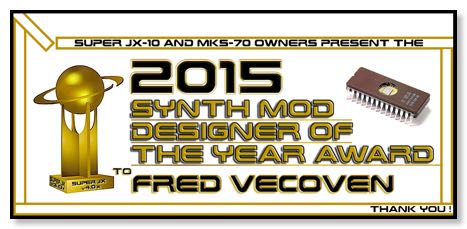swissdoc
back on duty
Gerade bei Matrixsynth gesehen:
http://www.vecoven.com/superjx/superjx.html
New features
In a nutshell, the rewrite provides :
New midi implementation
each parameter is now OFF/RECV/SEND/ON, allowing fine control of what gets sent and what is filtered.
sysex support : allow edition of patch, tone A and tone B individually. (No need for M64 cartridge)
fast bulk dump/load : 4-5 seconds to dump everything. Can dump to/from cartridge and internal memory.
edition of parameters (patch and tones) sends sysex, so all editions can be sequenced. PG800 is also supported here, so editions made from the PG800 can also be sequenced.
copy from/to cartridge to create a full backup of the internal memory (all settings are now copied to the cartridge or restored from it)
Controls C1 and C2 enhancements
any tone parameter can be assigned to C1 or C2
any arpeggiator parameter can be assigned to C1 or C2
C1 and C2 can be used, in tone edit mode, to modify upper/lower tone parameter. This allows quick editing of tones for those who don’t have a PG800.
Arpeggiator (JX10 only)
8 arpeggiators “patches”
internal or external synchronization
supports up, down up/down, played and random notes ordering
various arpeggio types
velocity setting (fixed or played)
note duration (1-15 or legato)
use lower split point to control which notes are arpeggiated
PG800 support
New display options
control whether updates from sysex, pg800 or controllers are displayed temporarily on-screen
Compatibility mode
allows to disable new features for full compatibility with old software (for example, sysex changes made to tone A can be redirected to the currently selected tone, etc...)
Test modes
test hardware controllers (voices, A/D controllers (aftertouch, bender, C1/C2), keyboard)
test memory chips
For MKS70 owners, please note that the MONO mode (one voice per midi channel) is NOT SUPPORTED in this release.
http://www.vecoven.com/superjx/superjx.html
New features
In a nutshell, the rewrite provides :
New midi implementation
each parameter is now OFF/RECV/SEND/ON, allowing fine control of what gets sent and what is filtered.
sysex support : allow edition of patch, tone A and tone B individually. (No need for M64 cartridge)
fast bulk dump/load : 4-5 seconds to dump everything. Can dump to/from cartridge and internal memory.
edition of parameters (patch and tones) sends sysex, so all editions can be sequenced. PG800 is also supported here, so editions made from the PG800 can also be sequenced.
copy from/to cartridge to create a full backup of the internal memory (all settings are now copied to the cartridge or restored from it)
Controls C1 and C2 enhancements
any tone parameter can be assigned to C1 or C2
any arpeggiator parameter can be assigned to C1 or C2
C1 and C2 can be used, in tone edit mode, to modify upper/lower tone parameter. This allows quick editing of tones for those who don’t have a PG800.
Arpeggiator (JX10 only)
8 arpeggiators “patches”
internal or external synchronization
supports up, down up/down, played and random notes ordering
various arpeggio types
velocity setting (fixed or played)
note duration (1-15 or legato)
use lower split point to control which notes are arpeggiated
PG800 support
New display options
control whether updates from sysex, pg800 or controllers are displayed temporarily on-screen
Compatibility mode
allows to disable new features for full compatibility with old software (for example, sysex changes made to tone A can be redirected to the currently selected tone, etc...)
Test modes
test hardware controllers (voices, A/D controllers (aftertouch, bender, C1/C2), keyboard)
test memory chips
For MKS70 owners, please note that the MONO mode (one voice per midi channel) is NOT SUPPORTED in this release.

